Fall of 1945
Scars of the Atomic Bomb
On September 14, 1945, the Special Committee for the Investigation of A-bomb Damages was established in the Ministry of Education's Scientific Research Council of Japan, and a survey team (hereinafter referred to as the "academic survey team") was organized, consisting of nine groups, including medical, physics, and biology groups.
The academic survey team authorized the Japan Film Corporation (Nippon Eiga-sha) to produce a documentary film of the atomic bomb damage. The Japan Film Corporation decided to add still photographers to its staff, and sought the assistance of Toho-sha and its talented cameramen.
It was determined that participation from Toho-sha would consist of Shunkichi Kikuchi in the academic survey team's medical group and Shigeo Hayashi in the physics group with an assistant, Tsuneo Tago.
The film crew of the academic survey team's medical group, which included Shunkichi Kikuchi, entered the city by train or three-wheeled motor vehicle from Kaita-cho, where they had been lodging while in Hiroshima. In Hiroshima the crew visited relief stations and hospitals that continued to provide medical treatment. While on the way to their destination, Kikuchi filmed buildings, plants, and any evidence of damage that attracted his attention.
His photographs illustrated the overwhelming destructive power of the atomic bomb, revealing how a single bomb unleashed such intense heat, blast, and fires that it crushed and burned the entire city in matter of hours.
 Looking southward from Yokogawa Station Location: Yokogawa-cho 3-chome Distance from hypocenter: approx. 1.8km Photograph taken from the overpass on the east end of the Yokogawa Station platform. The road running straight through the burnt ruins continues to the arched Yokogawa Bridge. The building to the left is the Hiroshima City Credit Union Headquarters. |
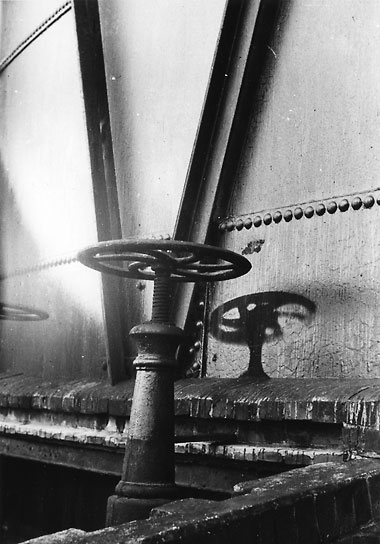 Shadow left on gas tank Location: Minami-machi 1-chome Distance from hypocenter: approx. 2km Gas tank at the Hiroshima Gas Company Hiroshima Plant. The coal-tar covering the surface melted from the heat rays and trickled off. The only portion that did not melt was where the handle screened the heat rays. That left what appeared to be a black shadow. |
|
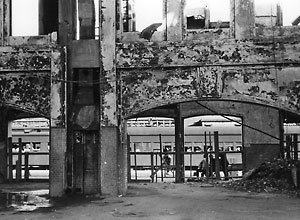 Inside Hiroshima Station Location: Matsubara-cho Distance from hypocenter: approx. 1.9km The interior of Hiroshima Station, whose ceiling collapsed and whose interior walls were burned out by the blast and fire. Although a mountain of rubble remained on the station house floor, trains at the platform are packed with people. |
| View from Hiroshima Savings Bureau (panoramic photograph) Location: Senda-machi 1-chome Distance from hypocenter: approx. 1.6km Panoramic photograph from Hiroshima Savings Bureau roof overlooking the area with north at center. | |
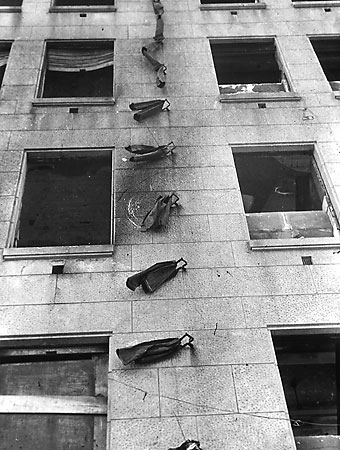 Looking up at the Chugoku Power Distribution Company Location: Ko-machi Distance from hypocenter: approx. 680m Most of the interior of this five-story reinforced-concrete office building was consumed by fire after igniting from the heat rays. This photograph was taken of the north wall, which faced the hypocenter. The downspout shown at the center was bent and torn to pieces by the blast. |
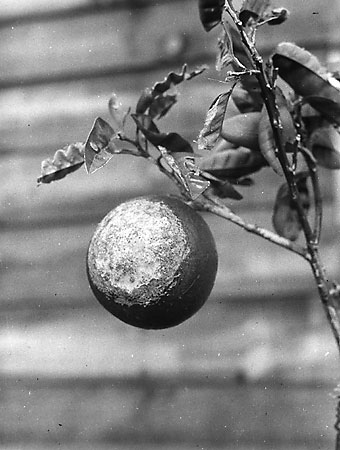 Sour orange (daidai) burned by heat rays Location: Koi-machi (now, Koi-ue) Distance from hypocenter: approx. 3.7km Here is a sour orange grown in the garden of a private house in Koi-machi. The half facing the hypocenter was burned by the heat rays. |
|
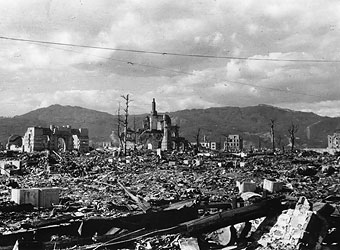 Hiroshima Agricultural Association and Nippon Savings Bank
Location: Onomichi-cho (now, Ote-machi 2-chome) Distance from hypocenter: approx. 450m
Photograph taken from the vicinity of the current NHK Hiroshima Broadcasting Station toward the northwest. The steeple-like ruins at the center are of the Hiroshima Branch of the Hiroshima Agricultural Association. To the left is the Hiroshima Branch of the Nippon Savings Bank. Hiroshima Agricultural Association and Nippon Savings Bank
Location: Onomichi-cho (now, Ote-machi 2-chome) Distance from hypocenter: approx. 450m
Photograph taken from the vicinity of the current NHK Hiroshima Broadcasting Station toward the northwest. The steeple-like ruins at the center are of the Hiroshima Branch of the Hiroshima Agricultural Association. To the left is the Hiroshima Branch of the Nippon Savings Bank. |
 Chugoku Military District Weaponry Division warehouse
Location: Moto-machi (now, Higashi-hakushima-cho) Distance from hypocenter: approx. 1.2km
Photograph taken toward the hypocenter from the Weaponry Division, which was located to the northeast of the hypocenter. The two brick-built warehouses, which stood parallel to each other, were destroyed by the blast in nearly the same manner. Chugoku Military District Weaponry Division warehouse
Location: Moto-machi (now, Higashi-hakushima-cho) Distance from hypocenter: approx. 1.2km
Photograph taken toward the hypocenter from the Weaponry Division, which was located to the northeast of the hypocenter. The two brick-built warehouses, which stood parallel to each other, were destroyed by the blast in nearly the same manner.
|
